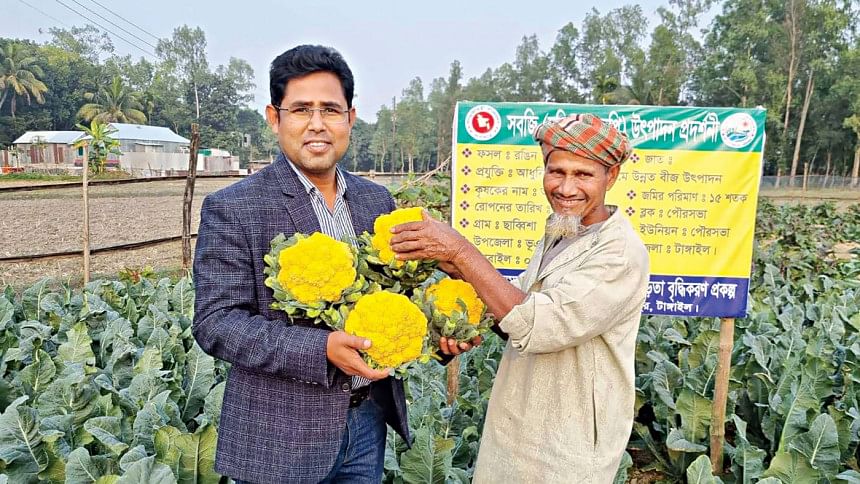Coloured cauliflower showing bright prospects

For the first time in Bangladesh, the Department of Agricultural Extension (DAE) has succeeded in growing coloured cauliflower on an experimental basis.
And seeing as coloured cauliflower provide good yields while also being slightly more nutritious than the traditional variety, local buyers are showing a keen interest in the crop.
According to sources at the DAE office in Mymensingh, a total of 60 farmers from 60 upazilas across six districts in the region were provided the necessary seedlings, pesticide and advice for cultivating coloured cauliflower.
The eye-catching variety of the crop is not only flying off the shelves in local markets, but buyers are also collecting it directly from the fields, farmers say.
So, famers in the region are becoming increasingly interested in cultivating coloured cauliflower as it is easy to grow and provides better returns than the white variety.
Red, yellow, pink and purple cauliflower were cultivated in areas under the Crop Intensification Project in greater Mymensingh.
Not only are they beautiful to look at, but coloured cauliflowers are more nutritious compared to the traditional variety as they contain a higher concentration of vitamins A and B and beta carotene.
There is also huge demand for this version of the crop both at home and abroad.
Ziaur Rahman, director of the Crop Intensification Project in Mymensingh, said they first saw that a local nursery in Jamalpur had cultivated coloured cauliflower using seeds from India while visiting the district back in 2021.
After collecting seedlings from the nursery, Rahman had a farmer in Barhatta upazila of Netrokona cultivate the crop while providing him the necessary support and got good yields.
"This time, by cultivating this type of cauliflower using 60 farmers in 60 upazilas, we made sure that the soil and climate conditions are conducive for producing good yields," he added.
Rahman went on to say that coloured cauliflower is turning heads at the moment as most people are seeing the crop for the first time.

"So, the price is a little high right now but if the crop is grown widely, then buyers would get it at a lower price," he said, adding that coloured cauliflower have high export potential.
With support from the DAE, Arshed Ali, a vegetable grower of Chhabisha village under Bhuanpur upazila in Tangail, cultivated yellow and pink varieties of cauliflower and got good yields from his one bigha farm.
Apart from seedlings, the DAE provided him with the necessary organic fertilisers, pesticides and advice.
"Buyers are paying farmers a good price for coloured cauliflower as they get sold out as soon as they reach the market," Ali said, adding that medium-sized cauliflower are being sold for Tk 50 per piece.
Spurred on by the good results, Ali now plans to expand cultivation next season.
Mohammad Ali, a farmer from the same village, said he took advice from Ali on cultivating coloured cauliflower.
"I hope to grow this crop in the future too," he added.

DAE sources say coloured cauliflower is grown the same way as the traditional variety with the sole caveat being that only organic fertilisers can be used.
The crop can be harvested just two-and-a-half months, or roughly 80 days, after planting the seedlings.
Dr Humayun Kabir, agriculture officer of Bhuanpur upazila, said local farmers initially showed little interest when the initiative was taken to grow coloured cauliflower.
Later, when Ali expressed interest, he was assisted by the DAE with the required seedlings, organic fertilisers and necessary advice.
"We wanted to see if the crop was suitable for cultivation in the local soil and climate and we have succeeded in this regard," he added.
Kabir then said this type of cauliflower is eaten as a salad in different countries, including Australia and China.

 For all latest news, follow The Daily Star's Google News channel.
For all latest news, follow The Daily Star's Google News channel. 








Comments